Analyzing this round of meme craze from the perspective of community and economic performance
- 王林forward
- 2024-05-04 21:01:081149browse
Original title: A Social and Financial Study of Memecoins
##Original author: Andrew Hong
Original compilation: Ladyfinger, Blockbeats
##Editor’s note:This article explores the meme currency in depth Current market behavior and impact, through a detailed analytical framework, reveal the diverse performance and investment potential of this category of cryptocurrencies. The data and charts in this article are sourced from a dataset compiled specifically for the Farcaster meme coin, providing a comprehensive perspective to help readers understand the community and financial performance of meme coins. By combining community data with financial data, the authors attempt to conduct a more scientific assessment and classification of such tokens to provide decision support for investors and analysts.
Introduction
Every market cycle is accompanied by the emergence of meme coins. If the concept isn’t familiar, consider the 2021 Reddit craze that drove up AMC’s stock price. A group of people rally around a meme to push the price of an asset higher over a short period of time, ranging from a day to a few months. This has become a popular marketing strategy in the crypto space from the blockchain layer to the application layer, as people are driving not just price, but attention to an ecosystem. Some projects like Avalanche have even created an official foundation for meme coins in order to go further.
The difference between a meme coin and any other token may not be very clear-cut, but oftentimes there is nothing behind the coin other than the meme image itself. For example, DOGE as a token is only really backed by a Shiba Inu image, unlike ETH which is secured by the Ethereum blockchain, UNI which is backed by the full Uniswap protocol, or MKR which is backed by a full collateralized stablecoin service.
Farcaster Meme coins like DEGEN are the latest trend and their main advantage is that their communities are publicly accessible. So I wanted to do some basic analysis combining community and financial data.
How to evaluate a meme coin
We can use the following chart to divide all meme coins:
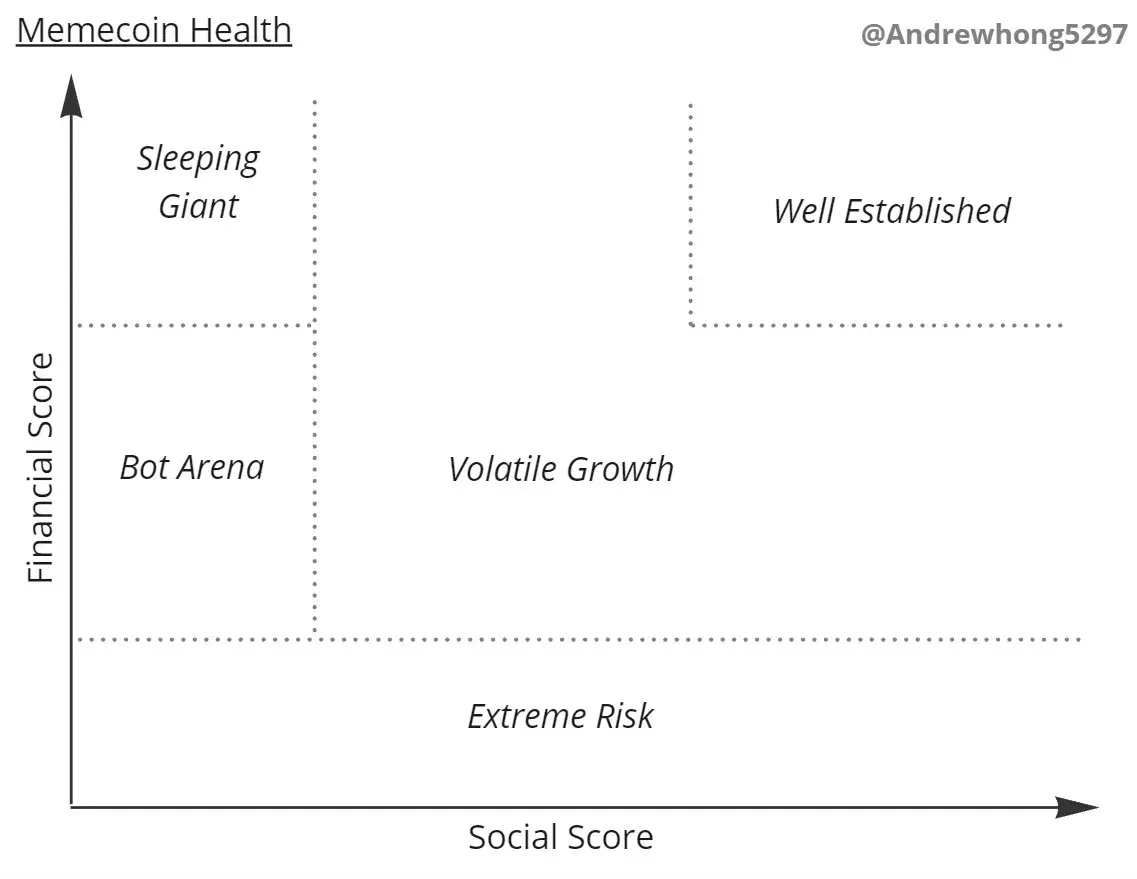 The above chart is divided into five Main areas:
The above chart is divided into five Main areas:
· Extreme Risk: Meme coins with low liquidity and trading volume are very dangerous and prone to RUG because there are too few liquidity providers
· Bot Arena: Most memes Coins will never break out of the war as thousands of coins and even many meme coins with the same or similar coin names are vying for community and asset attention
· Volatile Growth: Those Meme coins that have broken out of their initial period need to maintain their momentum and growth. During this period, you may see price fluctuations of 100-500%, whether the fluctuation is upward or downward, there will be many KOLs starting to latch on to this meme.
· Well Established: The leader in the meme coin market will occupy a high position in community attention and financial value for a period of time, forming a clear gap with other competitors. This lead may manifest itself as less price volatility, showing a kind of stability as the number of new investors interested in the meme coin balances with the number of investors exiting, thus maintaining interest in the meme coin. The meme coin continues to attract attention.
· Sleeping Giant: Meme coins that have grown significantly in community and funding and have not suffered from “RUG” may be temporarily dormant. It's likely that a DAO has been formed and they start rolling out minting or products and deal with the chaos in the community while hoping to get noticed again.
Most meme coins should be stuck in the "Bot Arena", with some high-profile meme coins in the "Volatile Growth" section, and maybe one or two meme coins can become "Well Established." In the process , some may lose community power and become "Sleeping Giants", while others may lose liquidity and become "Extreme Risk".
The roadmap of a successful meme coin should be like this:
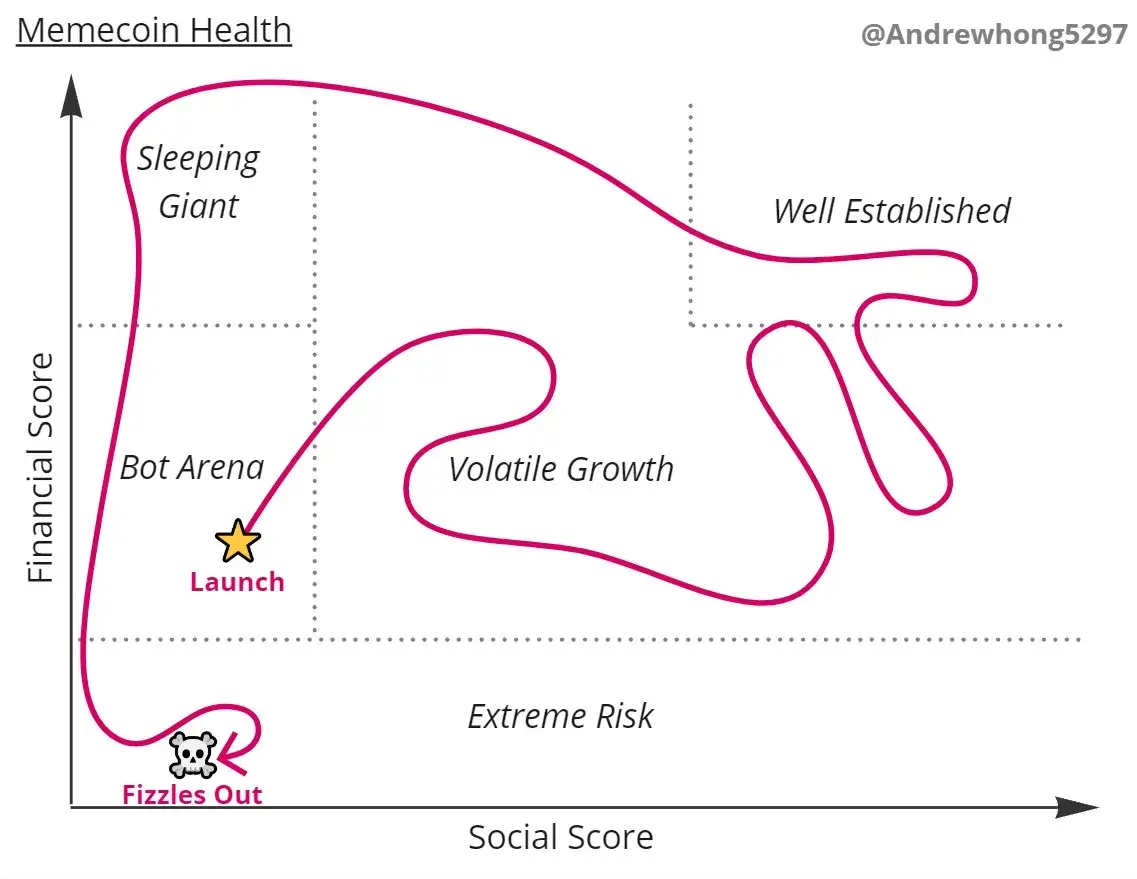 You may see many meme coins due to the promotion of bots or KOLs. The media attention is very high, but in fact their liquidity is not strong, which may expose investors to the risk of being "RUG", that is to say, if the project party suddenly withdraws liquidity, investors will Will suffer losses as a result.
You may see many meme coins due to the promotion of bots or KOLs. The media attention is very high, but in fact their liquidity is not strong, which may expose investors to the risk of being "RUG", that is to say, if the project party suddenly withdraws liquidity, investors will Will suffer losses as a result.
After a lot of data analysis, I created a chart related to the Farcaster meme coin on Dune:
This is actually pretty much what I expected, you can see DEGEN is at the far end in the upper right corner, and then some others like ENJOY , HIGHER , TN100 X and EVERY are in the middle. Other meme coins are stuck on the left, competing for attention and liquidity.
It’s worth noting that I’m not filtering out Sybil attacks or bots here, so the community ratings of some meme coins may be biased. This is a direction that can be improved in the future.
Now, let’s explain how these two ratings are derived from this final chart. I will also ask further research questions and detail my logic for those who want to dig deeper.
There are also some icons that I have not listed in this article. If you need them, you can find them here.
Community Score
Each score consists of a "Basic" part and a "Growth" part. For community ratings, we first measure token mention delivery and engagement. Therefore, according to this method, "$DEGEN" will be counted, but "DEGEN" will not. Token-related symbols such as degen hat, higher arrow, tn100 x ham will also be counted towards the total.
This gives us five main metrics:
· Droppers: the number of people who staked to a specific token
· % of recipients: these previous droppers Percentage of receiving the token
· Number of placements: Number of placements containing a specific token
· Number of channels: Number of channels that have placed placements containing a specific token
·Activity level: engagement (number of likes and replies) plus the number of placements multiplied by the cube root of the number of publishers multiplied by the cube root of the number of channels.
Overall community rating is calculated using a "Base" activity level and a "Growth" multiplier based on weekly changes in unique contributors and receivers. Essentially, if we see more and more people investing in a token, and those people are looking for ways to own those tokens, that's definitely a very healthy sign.
Overall, it looks like this in the table:
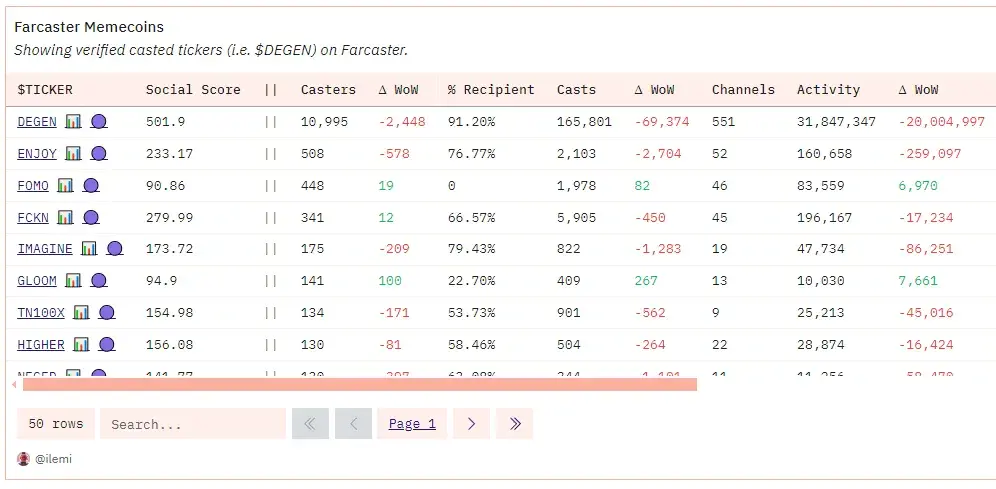
Funding Score
Here are a few financial metrics:
· Fully Diluted Value (FDV): fully diluted price, total supply x price
· Price: the latest price based on DEX transactions
· Daily, weekly, Monthly Price Change %: The percentage change in price on a daily, weekly and monthly basis
· Liquidity: This liquidity refers to non-token liquidity, meaning that for a DEGEN - WETH (Ether Square) capital pool, we only calculate the WETH part of it. Doing this gives us a more stable signal of how much good liquidity a given token has.
· Trading volume: DEX trading volume in the past 30 days
· Transfer volume: The number of ERC20 transfers in the past 30 days
· Total trading volume: USD in the past 7 days Trading volume on DEX
The "base" part of the financial score is determined by its non-token liquidity and the trading volume of the DEX, while the "growth" part is calculated based on week-on-week changes in liquidity . All in all, it looks like this in the form:
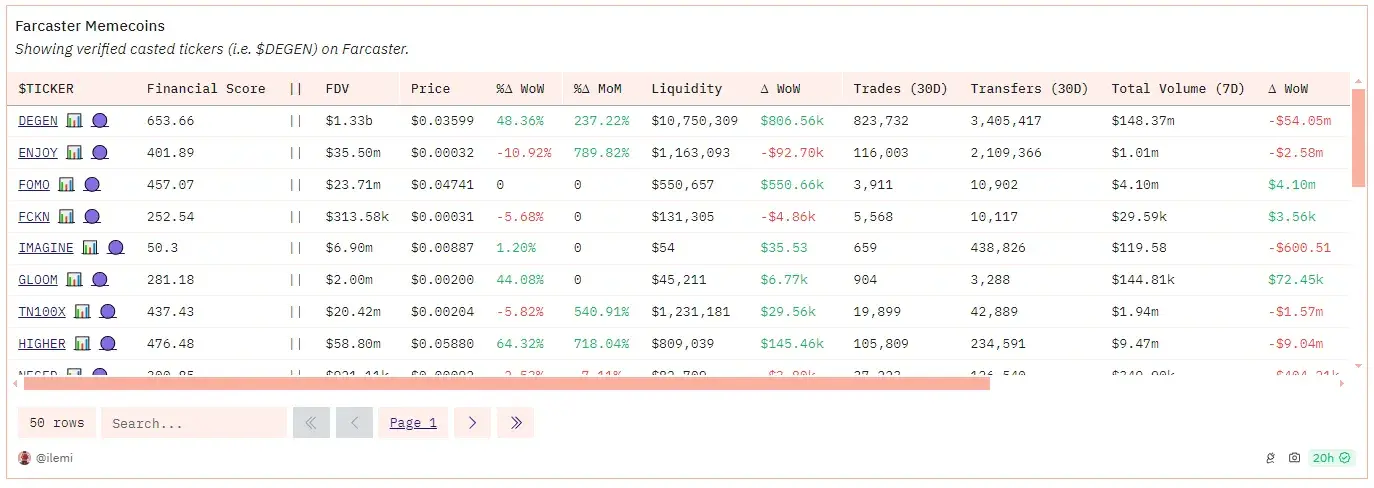
Follow-up questions
Here are some questions I hope to explore in depth from here:
· How to score "droppers" for Sybil attacks or bot behavior based on the value of tokens held in the wallet?
· Can Publishers be ranked based on their relationship to a known group or community?
· How are the stages of community and financial growth classified? What is the correlation between them? Are there any time lags or interdependencies?
· Are the same groups or types of people driving the initial growth phase? What are the characteristics of those who were the first, the latest, and the last to join a meme? How does this relate to the user's level?
· When a meme moves from one hot spot to another, what are the driving factors behind it?
· How is a person’s level of interest assessed in terms of their community or financial commitment? Do people change their “putting” behavior after buying or selling a specific token?
· What is the average lifespan of a meme on a community and financial level?
Data Query Guide
Although all the output here seems to come from a data set, in fact the data in the background is somewhat complicated. The relevant data can be queried according to the following guidance:
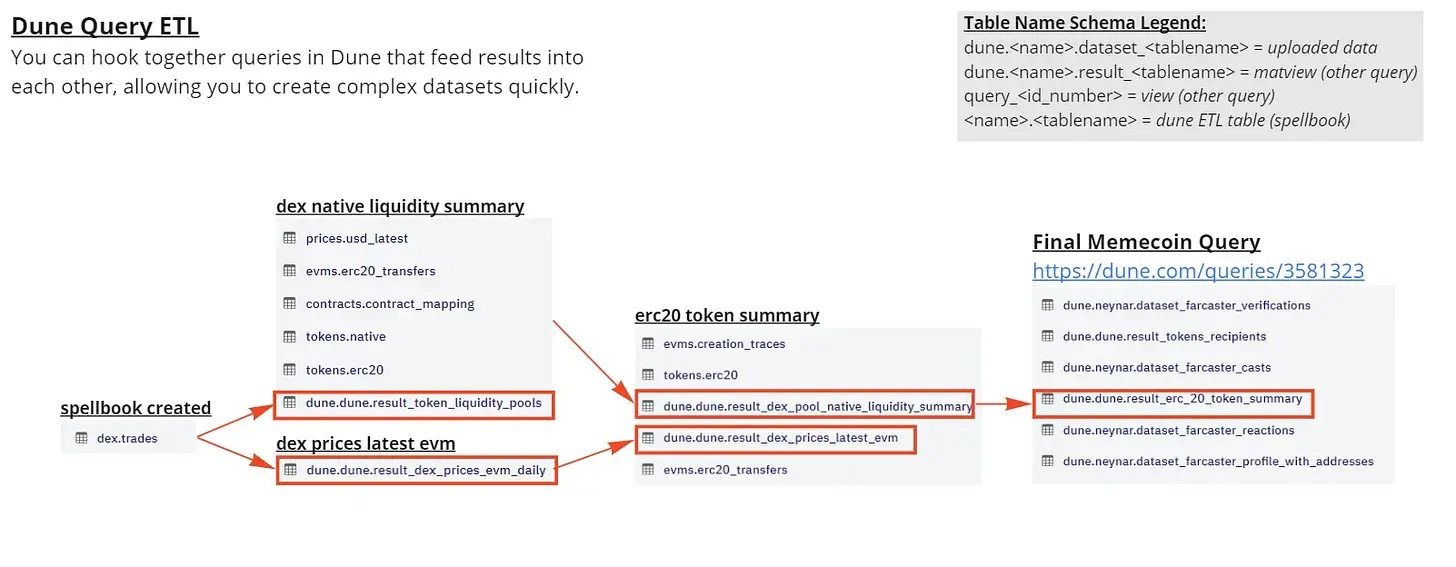
· dune.neynar... "The data set was uploaded by Neynar's team, which provides all Farcaster data Indexing. If you're not familiar with the concept of Farcaster data, start with my beginner's guide. Generally speaking, if you see "dataset" in the tab name, it means it is represented by "dune. "The team name displayed after the prefix is uploaded.
· As long as you see "result" in the table name, it is a matview. I created the "erc20 Token Summary Table" to get all trade, price, liquidity, and transfer data for a specific token. This summary table is further subdivided in subqueries so that the final query takes only 3 minutes to run. The total run time for all queries takes approximately 60-70 minutes.
· If you see a table name that does not follow the prefixes above (and is not an original or decoded table), then it is most likely from a spellbook. So tokens.erc20 gives me all tokens with a sign or decimal, dex.trades gives me all DEX trades on all blockchains and so on. You can find the logic of a table by searching the table namespace or table name (such as "dex" or "trades") in the github repository.
Summary
As a unique type of cryptocurrency, the market performance of meme coins is often strongly affected by community media and community dynamics. In addition to proposing a systematic framework for evaluating meme coins, through data analysis built on the Dune platform, we can more accurately monitor and predict the performance of these tokens.
Although there are certain challenges, such as the potential risk of Sybil attacks or Bot manipulation, through continuous monitoring and technical improvements, the analysis of meme coins can be more precise and practical. Future research may further deepen the understanding of these complex factors and bring new insights into the broader field of cryptocurrencies.
The above is the detailed content of Analyzing this round of meme craze from the perspective of community and economic performance. For more information, please follow other related articles on the PHP Chinese website!
Related articles
See more- What is the difference between Git and Github?
- Practical Blockchain-Hyperledger Fabric (1) 10-minute introduction for beginners
- How to delete a branch in git
- A collection of commonly used cryptocurrency exchange software in Hong Kong. Regular and official ranking of cryptocurrency browsers.
- Ethereum blockchain wallet address query

